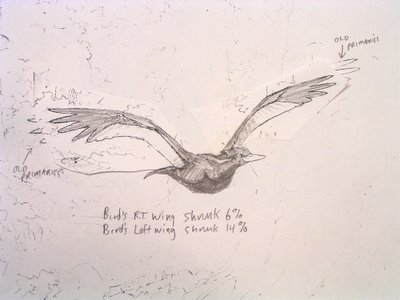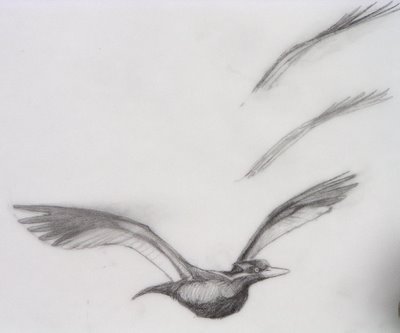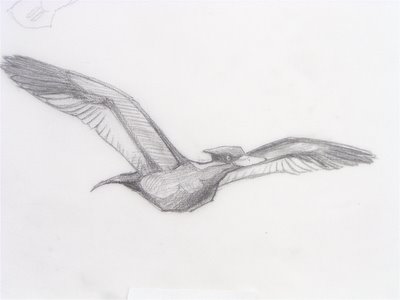Since I've become so camera-happy, I keep the little Olympus on the drawing table when I'm working, and anything remotely interesting gets recorded. I decided to take progress photos of this work because it would be my first cover painting for The Auk, the journal of the American Ornithologists' Union. I was a member of AOU for two shining years in the early 80's, until I got a load of how much the dues cost, and how quickly those journals piled up and weighed me down. In those days, I was moving as many as eight times a year, making (no kidding) $1200 a season as a field biologist for The Nature Conservancy, and I couldn't justify the expenditure or the extra weight. I already had enough boxes of crap I carried around with me. That's OK. I like being on the fringes of the field. I have ideas about birds, and especially how birds think, that no real ornithologist could ever admit to having. I'm in real good company. Ornithology has always been sustained by amateurs. Witness the furor Gene Sparling started in Arkansas...
So, on an ordinary morning, I send an email about an unbelievably dumb article I found in USA Today to Jerry Jackson, the ornithologist widely acknowledged as the world's foremost authority on the ivory-billed woodpecker.
"Jerry: I was taken aback by a half-page color illustration of an ivory-billed woodpecker adorning USA Today's November 10 "Life" section. It appeared to have been done from a photo of a very bad mount; as Bob Clem would say, "There was nothing right about it." My bemusement turned to amusement when I found the sections titled "Native habitat, Its sound, Life span, What's new, Its name..." Among these informative bits was this paragraph:
Why it's a sight to see
This woodpecker is light and can fly swiftly through the swamp forests. It has no jawbone or teeth and no vertebrae in its tail. Its bones are fused to provide support for flight. The birds sometimes fly above the trees when flying long distances to avoid branches.
Words fail me. "
We laugh about it, and then he writes back, "I was going to contact you today anyway. Is there any chance you would be interested in doing an Ivory-bill for cover art for the January issue of The Auk?" It was November 11. Knowing most magazines need art in a couple of months before press time, I was thrown into an instant panic. I emailed the editor, who said it would be good to get the painting by December 12 at the latest. I relaxed a little, but I still had a good job ahead. Fortunately, panic and I are old friends, and I leapt into sketching and composing. I knew one thing only: I wanted to paint the bird from an angle and in an attitude that hadn't been done before. I wanted a bird that would thrill the viewer, not something that looked like another static mount nailed to a dead tree. I wanted it flying right toward you, coming out of the gloom, alive.
A profile would not do. I didn't want this to look anything like what was already out there. I watched the David Luneau video about another hundred times, making rough sketches of the bird as it flapped away. There was a day and a half when I almost had myself convinced that was a pileated woodpecker in the video. Then I slept on it, watched it full-speed with well-rested eyes, and laughed at myself. There is no way, I told myself, no way that that's a pileated woodpecker. There is entirely too much white on the upstroke and the downstroke, white spanning the trailing edge of the wing. I kept drawing it. What if that bird were coming right at you? I turned it around in my head and drew that. I liked that view, and sent it to Jerry.
 He made a few suggestions, then a few more,
He made a few suggestions, then a few more, and before we knew it three days had gone by and I'd drawn and redrawn those wings and I didn't like the drawing anymore, and neither did he.
and before we knew it three days had gone by and I'd drawn and redrawn those wings and I didn't like the drawing anymore, and neither did he. In the end, we went with the first one I'd done. It had pizzazz. Neither of us was completely sure it was correct, but then neither of us has ever had an ivory-bill fly right at us at eye level. There aren't many people on the planet who can critique it, although I'm sure they will. This is the American Ornithologists' Union, after all. But I was not going to play it safe, and come up with another tepid ivory-bill image. Who needs that?
In the end, we went with the first one I'd done. It had pizzazz. Neither of us was completely sure it was correct, but then neither of us has ever had an ivory-bill fly right at us at eye level. There aren't many people on the planet who can critique it, although I'm sure they will. This is the American Ornithologists' Union, after all. But I was not going to play it safe, and come up with another tepid ivory-bill image. Who needs that? At this point, I'd rather try something new and be shot down than play it safe. I decide to go with the first draft. To be continued...
At this point, I'd rather try something new and be shot down than play it safe. I decide to go with the first draft. To be continued...





0 comments:
Post a Comment